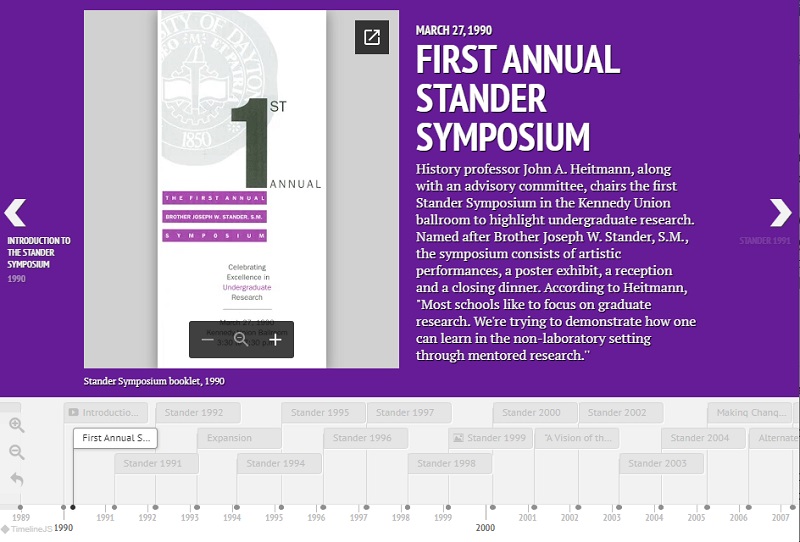University Libraries

32 Years of the Stander Symposium
By Bella Fusillo ’22
Browse Bella Fusillo's interactive timeline of the Stander Symposium
As a university student, the feeling of winning the lottery barely scratches the surface of what it feels like to hear that you have a Thursday with no classes. Until my second semester here at UD, I had no formal introduction to the Stander Symposium — only that it was listed next to the words “April 24: No Class” on all of my syllabi, and that was enough for me. I did eventually get to know Stander when my professor in the class Intro to the University Experience explained that this was no off-day, but a day of alternate learning. Basically, we still had homework. But I didn’t mind. At least I wasn’t sitting in a classroom on a beautiful spring day.
Serious scholarship
To fulfill our alternative learning requirements, we had to attend any three presentations, but at least one had to be history-related. I remember walking into Kennedy Union and seeing all the presenters and their families, and I felt severely underdressed in my gym clothes. Nonetheless, as I skimmed the list of presentations, I was surprised by the range of projects and creativity displayed in them. You tend to think that undergraduate research doesn’t really matter, that it’s just for your degree (especially when graduate schooling is becoming all the more desirable in the job market), but I remember appreciating that UD was recognizing the hard work being put in by its students and giving them a chance to show it off.
Research, performances, speakers, activities
When I started my research into the history of the Stander Symposium, I didn’t expect to find as much growth and change over the years as I did. The commitment to showcasing student creativity and community from the chairs and committees was obvious, even when I was reading something like a faculty-staff memo that simply outlined the sign-up process for students. The symposium was started to honor Brother Joseph W. Stander, S.M., a man who did it all. He came to UD as a student, then returned as a math professor. From there, he held many positions, including vice president of academic affairs and provost. He retired in 1989 and the first Stander Symposium was held one year later, in March of 1990; talk about making an impact!
Stander Symposium’s development went through many stages over the past 32 years. The symposium has worked with other shows and events on campus in a variety of ways throughout the years. Written works and visual arts have been on display in conjunction with both the Orpheus art show and the juried Horvath Show in past years. Through the UD Speaker Series, students have heard from leaders in education and innovation since 2012. Before the Speaker Series partnership, however, Stander had annual keynote speakers starting in 2005 with former New York Gov. Mario Cuomo. My personal favorite was from 2006, when Jane Goodall, the world-renowned primatologist and conservationist, came to campus to present her talk, “Reason for Hope.” As a close second — and something else I hadn’t heard of — was the TOMS Style Your Sole event. In 2010, Blake Mycoskie, founder and CEO of the shoe company TOMS, was the keynote speaker, but also hosted a pre-symposium event at ArtStreet when students could design their own pair of TOMS shoes. From 2005 to 2011, the Stander Cup was hosted by the health and sport science department in conjunction with Stander Symposium. During this event, groups of students participated in games at RecPlex based on athletic skill, teamwork and strategy.
projects and audience expand
Another area that caught my attention was the sheer size of Stander. The symposium didn’t expand outside of the Kennedy Union ballroom until 1993, but by 2006, events were held all across campus. The 1998 symposium was reported as the largest yet, hosting 87 poster projects. In comparison, though completely virtual, the 2020 event had 307 projects. I also had assumed that students always had the day off of classes for alternate learning, but it turned out that the first “Day at the Stander” didn’t occur until 2006. This adaptation, I believe, is what led to the success and popularity of Stander among the UD community. Being able to present to your peers and then go watch their presentations is by far the most exciting part of the Stander Symposium.
The Stander Symposium is continuously growing and adapting. From the implementation of campuswide events to the shift to virtual presentations in the midst of the COVID-19 pandemic, Stander has stood the test of time and continues to serve the UD community, shining a spotlight on the creative and intellectual young minds powering our future.
— Bella Fusillo is a junior history major from Lima, Ohio.
